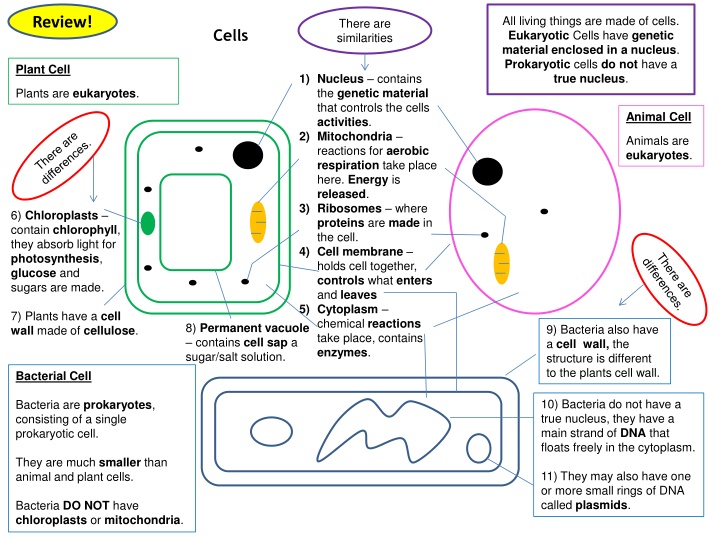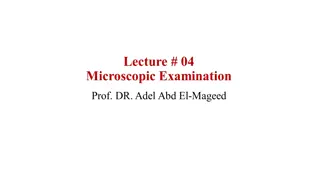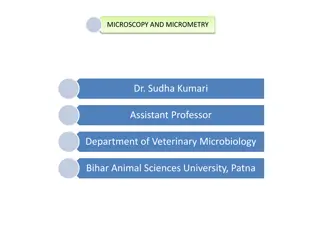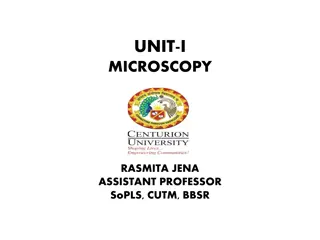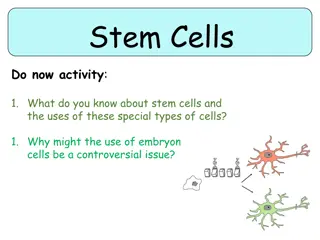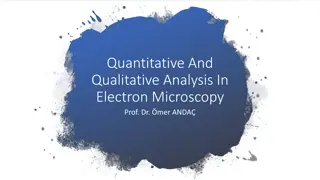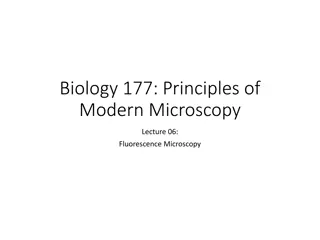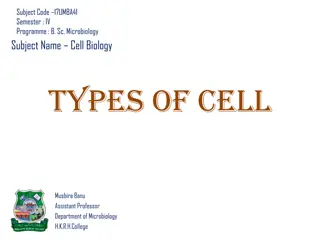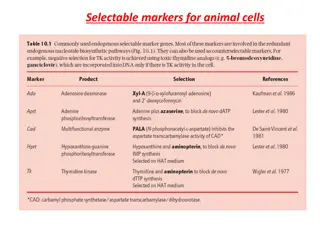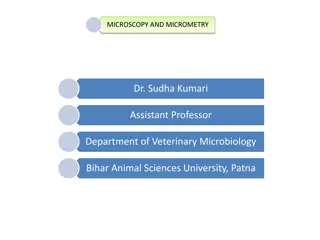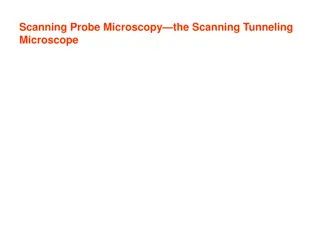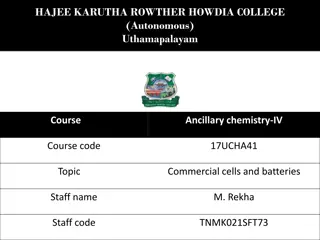Cells: Structure, Similarities, and Microscopy Mastering
Illuminate the world of cells with insights into their structures, the differences between plant, animal, and bacterial cells, as well as mastering microscopy techniques for in-depth analysis. Explore the fascinating realm of microscopic life forms through the lenses of science!
Download Presentation

Please find below an Image/Link to download the presentation.
The content on the website is provided AS IS for your information and personal use only. It may not be sold, licensed, or shared on other websites without obtaining consent from the author.If you encounter any issues during the download, it is possible that the publisher has removed the file from their server.
You are allowed to download the files provided on this website for personal or commercial use, subject to the condition that they are used lawfully. All files are the property of their respective owners.
The content on the website is provided AS IS for your information and personal use only. It may not be sold, licensed, or shared on other websites without obtaining consent from the author.
E N D
Presentation Transcript
All living things are made of cells. Eukaryotic Cells have genetic material enclosed in a nucleus. Prokaryotic cells do not have a true nucleus. Review! There are similarities Cells Plant Cell 1) Nucleus contains the genetic material that controls the cells activities. 2) Mitochondria reactions for aerobic respiration take place here. Energy is released. 3) Ribosomes where proteins are made in the cell. 4) Cell membrane holds cell together, controls what enters and leaves 5) Cytoplasm chemical reactions take place, contains enzymes. Plants are eukaryotes. Animal Cell Animals are eukaryotes. 6) Chloroplasts contain chlorophyll, they absorb light for photosynthesis, glucose and sugars are made. 7) Plants have a cell wall made of cellulose. 8) Permanent vacuole contains cell sap a sugar/salt solution. 9) Bacteria also have a cell wall, the structure is different to the plants cell wall. Bacterial Cell 10) Bacteria do not have a true nucleus, they have a main strand of DNA that floats freely in the cytoplasm. Bacteria are prokaryotes, consisting of a single prokaryotic cell. They are much smaller than animal and plant cells. 11) They may also have one or more small rings of DNA called plasmids. Bacteria DO NOT have chloroplasts or mitochondria.
Review! Useful Conversions X 1000 X 1000 mm m nm 1000 1000 3 mm = 3000 m 20, 000 m = 20 mm 40 m = 40, 000 nm 60, 000 nm = 0.06 mm X 60 X 1000 min s Kg g 60 1000 5 min = 300 s 960 s = 16 min 5 kg = 5000 g 850 g = 0.85 kg
-3 Standard form: e.g. 0.0025 = 2.5 x 10 The number of places the decimal point moves becomes the power. If it moves right the power is negative. Review! Microscopy Cells Are Studied Using Microscopes Most cells and organelles are too small to be seen with the naked eye, so we need microscopes to see them. Light microscopes use light and lenses to magnify cells so we can view them and also the larger subcellular structures such as nuclei. Magnification and resolution are quite low (x1500 and 200nm). Electron microscopes use electrons to form an image. They have a highermagnification and resolution (x500 000 and 0.1nm). Electron microscopes allow us to see smaller things in more detail, inside cells and organelles and even the surface of cells. Example 0.017 = 1.7 x 10-2 Image size real size X magnification Magnification = image size / real size Exam Question Magnification and Resolution A cell that is 17 micrometres in diameter appears to be 3.4cm in diameter when viewed through a microscope. Calculate the magnification (3 marks). Equation then (insert) Parameters then (check) Units EPU Magnification means how much larger the image is than the specimen. Magnification = image size/ real size Resolution (or resolving power) means the ability for the microscope to distinguishtwo close together images as being separate. Magnification = 3.4 / 17 m Magnification = 34000 m / 17 m Magnification = x2000
Review! Microscopy Mastery ANSWERS Image size Conversions 1) If a cell measures 2 x 103 nm how many m is this? 2 m 2) If a cell measures 5 x 103 nm how many m is this? 5 m 3) If a cell measures 70 m how many nm is this? 70, 000 nm 4) If a cell measures 45 m how many nm is this? 45, 000nm 5) A bacterial cell is one-tenth the width of a eukaryotic cell. The eukaryotic cell is 2 m wide. Calculate the width of a bacterial cell. Give your answer in nm using standard form. 0.2 m = 200 nm = 2 x 102 nm real size magnification Standard Form Microscopy Convert into standard form: 1) 17000 = 1.7 x 104 2) 0.006 = 6 x 10-3 3) 250 = 2.5 x 102 4) 0.000008= 8 x 10-6 5) 740000 = 7.4 x 105 1) Mag = image size/ real size. Image size = 3cm actual size = 12 m Mag = 30000/12 mag = x 2500 2) Mag = image size/ real size. Image size = 5cm actual size = 25 m Mag = 50000/25 mag = x 2000 3) Real size = image size/mag mag = x100 image = 7.5mm = 7500 m Real = 7500/100 = 75 m 4) Real size = image size/mag mag = x200 image = 5 mm = 5000 m Real = 5000/200 = 25 m 5) Image size = mag x real size mag = x 8000 real = 6 m Image = 8000 x 6 = 48000 m = 48 mm Convert into number: 1) 4.5 x 103 = 4500 2) 1.8 x 105 = 180000 3) 2.9 x 10-2 = 0.029 4) 5.6 x 108 = 560000000 5) 7.4 x 102 = 740 mm m nm
Review! Cell Differentiation and Specialisation Cells Differentiate to Become Specialised Cells have different structures to suit their function (job). A cell changes to become specialised for its job during a process called differentiation Certain cells can change to carry out a particular function, they turn into different types of cell by developing different structures. Most differentiation occurs as the organism develops, but lots of plants cells are able to continue differentiating. Most animal cells can no longer continue to differentiate, after specialisation has occurred. Some differentiation still occurs in mature animals, mainly the cells used for repairing and replacing cells, such as skin or blood cells. Some cells are undifferentiated (such as in the bone marrow), they are stem cells. Embryos have undifferentiated cells, stem cells, as the cells divide, each cell is exposed to a certain hormone or chemical making it start to differentiate. Learn These Examples of Specialised Cells- Find a Picture and Stick it in! Cell Structure Function Sperm - Reproduction, supplies 23 chromosomes Long tail and streamlined head Lots of mitochondria Carries enzymes in the head Help swim to egg Provide the energy to swim Digest egg cell membrane Nerve Cells - Rapid signalling, carry electrical signals from one part of body to another Cells are very long Branched connections at the ends To cover the distance required To connect to other nerve cells and form a network throughout the body. Muscle Cells To contract quickly Cells are very long Lots of mitochondria To have space to contract Provide the energy to contract Root Hair Cells Absorb water and minerals Cells on the surface of plant roots grow into long hairs, that stick out into soil. Increase the surface area for absorbing water and mineral ions.( diffusion rate) Xylem and Phloem Cells for transport e.g. water and sugars Cells are long and joined end to end Xylem are hollow, phloem have very few organelles and holes in the end plates To create a tube for substances to move through Holes in end plates allow sugars to move through
Review! Chromosomes and Mitosis Chromosomes Contain Genetic Information The Cell Cycle Most body cells have a nucleus. The nucleus contains the genetic material. The genetic information is made of DNA molecules, lengths of which are coiled up into chromosomes. Each chromosome has a large number of genes, different genes control the development of different characteristics e.g. eye colour Body cells have 2copies of each chromosome, 1 from the mother and 1 from the father. 23 pairs. Multicellular organisms body cells divide to produce new cells in stages called a cell cycle. The part of the cycle when the cell divides is called mitosis. Mitosis is used for growth and repair. Two new cells are produced, identical to original with same number of chromosomes. Learn these two stages: Growth and DNA Replication Before the cell divides it must grow and sub-cellular structures (organelles) are doubled e.g. mitochondria. (G1 Phase, first gap phase.) The DNA is then duplicated, at this point the shape looks a lot like an X (not to be confused with the actual X-chromosome). (S Phase, synthesis) The DNA is checked for errors. (G2 phase, second gap phase.) Mitosis can then occur (M phase.) Mitosis Add a Picture! During mitosis, first the chromosomesline up at the centre of the cell, cell fibres pull them apart. The two arms of each chromosome go to oppositeends of the cell. Membranes form around each of the sets of chromosomes, these become the two new nuclei the nucleus has divided. Finally the cell membrane and cytoplasmdivide. Two new daughter cells have been produced, identical to the original cell, with exactly the sameamount of DNA which is also identical (otherwise known as a clone).
Review! Binary Fission Prokaryotic cells replicate by binary fission 1) The DNA and plasmidsreplicate. 2) The cells get bigger and the DNA strands move to opposite poles (ends) of the cell. 3) New cell walls begin to form, cytoplasm starts to divide. 4) Cells fully divide producing twodaughtercells. They will have one copy of the main DNA strand, but variable copies of plasmids. 1 In the correct conditions, bacteria can divide very quickly, e.g. warm, lots of nutrients. When conditions are unfavourable, bacteria stop dividing and eventually die. The meandivisiontime is the average amount of time it takes for one bacterial cell to divide into two. From it you can work out how many divisions took place (in the time), and the number of cellsproduced. 2 Exam Question A bacterial cell has a mean division time of 30 mins. How many cells would it produce after 3.5 hours? 3 4 3.5 hours = 210 mins 210 / 30 = 7 divisions 7 2 x 2 x 2 x 2 x 2 x 2 x 2 = 2 The population doubles after every division: 1 x 2 = 2, 2 x 2 = 4, 4 x 2 = 8 = 128 cells
Review! Binary Fission Mastery ANSWERS Bacterial Population Size 1) A bacterial cell has a mean division time of 20 mins. How many cells would it produce after 3 hours? 3 x 60 = 180mins/ 20 = 9 divisions 29 = 512 2) A bacterial cell has a mean division time of 12 mins. How many cells would it produce after 2 hours? 2 x 60 = 120mins/ 12 = 10 divisions 210 = 1024 3)There were 10 bacteria in the original colony. The bacteria divided once every 30 mins. How many bacteria were in the colony after 12 hours? 12 x 60 = 720mins/ 30 = 24 divisions = 10 x 224 167772160 = 1.68 x 108 4) There were 6 bacteria in the original colony. The bacteria divided once every 11 mins. How many bacteria were in the colony after 5.5 hours? 5.5x 60 = 330mins/11 = 30 divisions = 6 x 230 6442450944 = 6.44 x 109 5) A bacterial colony of 100,000 bacteria divides every 24 minutes. How many bacteria will there be after six hours. 6 x 60 = 360mins/ 24 = 15 divisions = 100000x 215 = 3276800000 = 3.28 x 109 Calculating Cross-Sectional Area Using r2 1) The clear area around a bacterial colony is 11mm in diameter. Calculate the cross-sectional area of the clear area. x 5.52 = 95.0 mm2 2) The clear area around a bacterial colony is 400 m in diameter. Calculate the cross-sectional area of the clear area. x 2002 = 125664 = 1.3 x 105 m2 3) One colony of a bacteria has a diameter of 5mm. What is the cross-sectional area of the colony? x 2.52 = 19.64 mm2 4) One colony of a bacteria has a radius of 5mm. What is the cross-sectional area of the colony? x 52 = 78.54 mm2 5) One colony of a bacteria has a radius of 7mm. What is the cross-sectional area of the colony? x 72 = 153.94 mm2
Stemcells are undifferentiated cells that can becomeany type of specialised cell. Stem Cells Review! Embryonic Stem Cells Can Turn Into Any Type of Cell Stem Cells Can Produce Identical Plants Stem cells, can divide to produce lots more undifferentiated cells. When a cell changes to becomespecialised it undergoes a process called differentiation. Stem cells are found in early human embryos all of our specialised cell types come from just a few original stem cells. Adults have stem cells e.g. in the bonemarrow. They can t turn into every type of cell, only certaintypes e.g. blood cells. Cells can be taken from embryos and bone marrow, grown in a lab to multiply (produce clones) and made to differentiate (by giving chemicals and hormones). They are used in medicine or research. A plant s stem cells are found in the parts of the plant where growth occurs, the meristems. Cells in the meristem tissues can differentiate into anytype of plant cell, throughout the plant s whole life. Whole plants can be produced quickly and cheaply from these stem cells, they are identical copies (clones). This is useful to prevent rare species from being wiped out and becoming extinct. There are important farming applications, to produce crops of identical plants that have desired features e.g. diseaseresistance. Stem Cells May Be Able to Cure Many Diseases Adult stem cells are already being used to curedisease. E.g. faulty blood cells can be replaced by transferring stem cells from the bone marrow of a healthy person. Embryonic stem cells potentially have many uses, e.g. make insulin producing cells for people with diabetes. Therapeuticcloning is where an embryo could be made to have the samegenetic information as the patient. The stem cells produced from it would contain the same genes, so wouldn t be rejected by the immune system if used to replace faulty cells. There are ethical issues of using embryonic stem cells, each embryo is a potential life and cannot object to the treatment. Another argument is that curing patients who are suffering is moreimportant than the rights of embryos. Embryos used in research are often those left over from fertility treatment which would be destroyed anyway. There are risks in using stem cells a virus could contaminate the cells and be passed on to the patient.
Review! Diffusion What is Diffusion? Diffusion is the spreading out of particles from an area of higherconcentration to an area of lower concentration. The movement is random, eventually the particles become evenly spaced. Diffusion happens in both solutions and gases, as the particles are free to move about randomly. Example: When perfume diffuses through the air, the random movements of both gases causes the perfume to spread and diffuse, to be able to be detected in other locations (both gases are diffusing). The bigger the concentrationgradient i.e. the bigger the difference in concentration, the faster the diffusionrate. Cell membrane Cell Membranes Allow substances to move in and out by Diffusion Diffusion is a passive process does not require energy. Only very small molecules can move through a cellmembrane by diffusion e.g. oxygen, glucose, amino acids and water. Waste e.g. urea, leaves the cell. Big molecules like starch and protein cannot fit through the membrane. Particles move randomly, they may move both in and out of the cell, there will be a net (overall) movement from the area of a higher concentration to the area of the lower concentration. The larger the surface area of the membrane, the faster the rate of diffusion, as more particles can move through at once. time equilibrium Factors that make the Rate of Diffusion Increase: The concentrationgradientincreasing (the difference in the concentrations increases). Increasedtemperature, this increases the kineticenergy of the particles so they move faster. Surfaceareaincreasing there is more area to be able to move through.
Review! Osmosis A special type of diffusion. What is Osmosis? Osmosis is the movementof water molecules from an area of higherconcentration (dilute) to an area of lowerconcentration (more concentrated), through a partially permeable membrane. A partially permeable membrane has small holes, so only small molecules like water can pass through and larger ones like sucrose cannot. Water molecules do pass through both ways, the movements are random. Because there are more water molecules on one side than the other, there is a steady netflow of water into the area where there are fewer water molecules into the more concentrated area. The sucrose solution becomes more dilute, the water concentration becomes evenly balanced. Therefore osmosis is the diffusion of water, it is passive does not require energy. Cell membrane Plant Cells sucrose Water moves both ways, sucrose cannot pass through. If plant cells are placed into a dilute solution (hypotonic), water moves into the cell, it will swell and become turgid. The cellulose cell wall prevents it from bursting. If they are placed into an isotonic solution (sameconcentration as cell), water moved in and out evenly and the cell remains the same. If the cells are placed into a more concentrated solution (hypertonic), water moves out of the cell, the plant cell becomes flaccid and eventually becomes plasmolysed (the cell membrane comes away from the cell wall). time equilibrium Animal Cells If animal cells are placed into a dilute solution (hypotonic), water moves into the cell, it will swell and eventually burst. If they are placed into an isotonic solution (sameconcentration as cell), water moved in and out evenly and the cell remains the same. If the cells are placed into a moreconcentrated solution (hypertonic), water moves out of the cell, they shrivel and crenate.
Review! This process requires energy. Active Transport What is Active Transport? Activetransport is the movement of particles against the concentration gradient, from a lower to a higher concentration. This requires energy from respiration. The substances move from a less concentrated area to a more concentrated area across the cell membrane using carrierproteins. TO HIGH LOW Root Hairs Take in Minerals During Active Transport Roothaircells are cells that have grown hairs which stick out into the soil. This extra membrane gives the plant a larger surfacearea for absorbingwater and mineral ions from the soil. Mineral ions are needed for healthy growth but the concentration is higher in the root hair cell than the soil. Proteincarriers in the membrane use energy from respiration to absorb materials from a very dilute solution against a concentration gradient. This process is called activetransport. Active Transport Occurs in the Gut In the smallintestine as food is broken down during digestion, initially there is a higherconcentration of nutrients e.g. glucose, than in the blood. Therefore diffusion will occur and the glucose etc. will move into the blood, eventually equilibrium will occur and diffusion will stop when there is no longer a higher concentration in the small intestine. Activetransport is then used to move remaining nutrients into the bloodstream. Nutrients then move from a lower concentration in the small intestine into the higher concentration in the blood, against the concentration gradient, by carrierproteins in the membrane, using energy from respiration. The nutrients are carried in the blood to the cells that require them, e.g. glucose is used by all cells for respiration.
Review! Exchange Surfaces Surface Area to Volume Ratio SA:V How easily (quick) energy and substances move between an organism and its environment depends on its surface area to volume ratio. Organisms Exchange Substances With Their Environment Calculate Surface Area: Volume What is the surface area to volume ratio of a cube that has sides that are 2cm in length? (3 marks) Cells can takein substances they need and get rid of waste products by diffusion. The area of eachside of the cube is 2cm x 2cm = 4cm2 There are 6 faces on a cube therefore the surfacearea is 6 x 4cm2 = 24cm2 Examples: Oxygen and carbondioxide are transferred between cells and the environment during gas exchange. Urea is a waste product produced from the breakdown of excess aminoacids, it diffuses from cells into the bloodplasma for removal from the body by the kidneys. The volume is 2cm x 2cm x 2cm = 8cm3 Therefore the surface area to volumeratio is 24: 8 This can be simplified to 3:1 Multicellular Organisms Need Exchange Surfaces In single-celled organisms diffusion can occur directly into or out of the cell across the cell membrane. They have a largesurfacearea compared to their volume, so enough substances can be exchanged to supply the cell. Multicellular organisms have a smallersurfacearea compared to their volume, so notenoughdiffusion can occur across the surface to meet the needs of the body. They require exchangesurfaces for the diffusion to occur. Exchange surfaces are adapted, i.e. their structure allows them to carry out their function i.e. Have a thinmembrane for a shortdiffusiondistance (pathway). Largesurfacearea, for a faster rate of diffusion. Exchange surfaces in animals have a goodbloodsupply, for fasterrate of diffusion into and out of the blood.
Review! Exchanging Substances Parts of the body are adapted so that the diffusion is most effective. Absorption in the Small Intestine Gas Exchange in the Lungs The inside of the small intestine is covered in millions of small projections called villi. The villi are specialised to maximise the amount and rate of diffusion by having; A huge surface area A single layer of surface cells A good blood supply The function of the lungs is to transfer oxygento the blood and carbondioxideaway from it. The lungs contain millions of alveoli (air sacs) where the gas exchange takes place. The alveoli are specialised to maximise the amount and rate of diffusion by having; A huge surface area Very thin walls Good blood supply Moist lining to dissolve the gases. Gas Exchange in Fish Gas exchange occurs across the gills in fish. Waterentersthe fish s mouth and passes out through the gills. Carbondioxide diffuses out and oxygen diffuses into the blood in the gills. Each gill is made of lots of thinplates called gill filaments which give a bigsurfacearea for exchange of gases. The gill filaments are covered in lamellae to further increase the surface area. The lamellae have a good blood supply to speed up rate of diffusion. They have a thinlayer of cells for a shorter diffusion distance. Blood flows through the lamellae in one direction and water in the other. This maintains a large concentration gradient between water and blood. Gas Exchange in Leaves Carbon dioxide diffuses into the airspaces within the leaf, then diffuses into the cells for photosynthesis. The underside of the leaf is adapted as an exchange surface by having pores called stomata. Oxygen produced in photosynthesis, and water vapour diffuseout through the stomata. The size of the stomata are controlled by guardcells, they can close the stomata to prevent water loss. The flattened shape of the leaf increase the area of the exchange surface. Airspaces inside the leaf allow gas to surround the walls of the cells, increasing the chance of gas exchange.
All living things are made of cells. Eukaryotic Cells have genetic material enclosed in a ... Prokaryotic cells have a true nucleus. There are similarities Do! Cells Plant Cell 1) . contains the genetic material that controls the cells .. 2) . reactions for aerobicrespiration take place here. .. is released. 3) where .. are made in the cell. 4) Cell .. holds cell together, . what enters and leaves 5) chemical reactions take place, contains .. Plants are .. Animal Cell Animals are ... 6) . contain chlorophyll, they absorb light for ., .. and sugars are made. 7) Plants have a . made of . 8) Permanent . contains cell .. a sugar/salt solution. 9) Bacteria also have a cell .., the is different to the plants cell wall. Bacterial Cell 10) Bacteria do not have a true nucleus, they have a main strand of that floats freely in the . Bacteria are ., consisting of a single prokaryotic cell. They are much . than animal and plant cells. 11) They may also have one or more small rings of DNA called .. Bacteria DO NOT have chloroplasts or .
Useful Conversions Do! X 1000 X mm m nm 1000 3 mm = m .. m = 20 mm 40 m = .. nm .. nm = 0.06 mm X . X min s Kg g .. 5 min = s s = 16 min 5 kg = g .. = 0.85 kg
-3 Standard form: e.g. 0.0025 = 2.5 x 10 The number of places the decimal point moves becomes the ... If it moves rightthe power is . Microscopy Do! Cells Are Studied Using Microscopes Most cells and organelles are too .. to be seen with the naked eye, so we need to see them. Light microscopes use and to magnify cells so we can view them and also the larger subcellular structures such as nuclei. Magnification and resolution are quite (x1500 and 200nm). Electron microscopes use .. to form an image. They have a ..magnification and resolution (x500 000 and 0.1nm). Electron microscopes allow us to see smaller things in more , inside cells and organelles and even the surface of cells. Example 0.017 = 1.7 x 10 .. Image size .. .. X Magnification = image size / .. Exam Question Magnification and Resolution A cell that is 17 micrometres in diameter appears to be 3.4cm in diameter when viewed through a microscope. Calculate the magnification (3 marks). Equation then (insert) Parameters then (check) Units EPU Magnification means how much the image is than the specimen. Magnification = Resolution (or resolving power) means the ability for the microscope to .. close together images as being . Magnification = Magnification = Magnification =
Microscopy Mastery Do! Image size Conversions 1) If a cell measures 2 x 103 nm how many m is this? 2) If a cell measures 5 x 103 nm how many m is this? 3) If a cell measures 70 m how many nm is this? 4) If a cell measures 45 m how many nm is this? 5) A bacterial cell is one-tenth the width of a eukaryotic cell. The eukaryotic cell is 2 m wide. Calculate the width of a bacterial cell. Give your answer in nm using standard form. real size magnification Standard Form Microscopy 1) Calculate the magnification of a cell that is 12 m wide and appears 3cm wide under the microscope. 2) Calculate the magnification of a cell that is 25 m wide and appears 5cm wide under the microscope. 3) An onion cell is viewed under a microscope with x100 magnification. The image of the cell is 7.5mm wide. What is the real width of the onion cell? Give your answer in m. 4) A muscle cell is viewed under a microscope with x200 magnification. The image of the cell is 5 mm wide. What is the real width of the muscle cell? Give your answer in m. 5) What is the size of the image formed, when a nucleus of real size 6 m is viewed under a magnification of x8000? Give your answer in mm. Convert into standard form: 1) 17000 2) 0.006 3) 250 4) 0.000008 5) 740000 Convert into number: 1) 4.5 x 103 2) 1.8 x 105 3) 2.9 x 10-2 4) 5.6 x 108 5) 7.4 x 102 mm m nm
Do! Cell Differentiation and Specialisation Cells Differentiate to Become Specialised Cells have different structures to suit their .. (job). A cell changes to become specialised for its job during a process called .. Certain cells can change to carry out a particular function, they turn into different types of by developing different structures. Most differentiation occurs as the organism . , but lots of plants cells are able to differentiating. Most animal cells can no longer continue to differentiate, after specialisation has occurred. Some differentiation still occurs in mature animals, mainly the cells used for .. and replacing cells, such as skin or .. cells. Some cells are undifferentiated (such as in the bone marrow), they are cells. Embryos have undifferentiated cells, stem cells, as the cells divide, each cell is exposed to a certain .. or chemical making it start to differentiate. Learn These Examples of Specialised Cells- Find a Picture and Stick it in! Cell Structure Function Sperm - Reproduction, supplies 23 chromosomes Long .. and . head Lots of mitochondria Carries enzymes in the head Help swim to egg Provide the to swim egg cell membrane Nerve Cells - Rapid signalling, carry electrical signals from one part of body to another To cover the distance required To to other nerve cells and form a network throughout the body. Cells are very .. Branched connections at the ends Muscle Cells To contract quickly Cells are very long Lots of To have space to . Provide the energy to contract Root Hair Cells Absorb water and minerals Cells on the surface of plant roots grow into .. hairs, that stick out into soil. Increase the .. area for absorbing water and mineral ions.( diffusion rate) Xylem and Phloem Cells for transport e.g. water and sugars Cells are long and .end to end Xylem are hollow, phloem have very few organelles and holes in the end plates To create a tube for substances to move through Holes in end plates allow ..to move through
Do! Chromosomes and Mitosis Chromosomes Contain Genetic Information The Cell Cycle Most cells have a nucleus. The nucleus contains the material. The genetic information is made of . molecules, lengths of which are coiled up into .. Each chromosome has a large number of . , different genes control the development of different e.g. eye colour Body cells have 2copies of each chromosome, 1 from the mother and 1 from the father. .. pairs. Multicellular organisms body cells divide to produce new cells in stages called a cell . . The part of the cycle when the cell divides is called .. Mitosis is used for growth and .. . new cells are produced, identical to original with same number of .. . Learn these two stages: Growth and DNA Replication Before the cell divides it must . and sub-cellular structures ( ..) are doubled e.g. mitochondria. (G1 Phase, first gap phase.) The DNA is then .. , at this point the shape looks a lot like an X (not to be confused with the actual X-chromosome). (S Phase, synthesis) The DNA is .. for errors. (G2 phase, second gap phase.) can then occur (M phase.) Mitosis Add a Picture! During mitosis, first the .. line up at the centre of the cell, cell fibres pull them apart. The two arms of each chromosome go to ends of the cell. Membranes form around each of the sets of chromosomes, these become the two new .. the nucleus has divided. Finally the cell membrane and cytoplasm ... Two new daughter cells have been produced, .. to the original cell, with exactly the sameamount of .. which is also identical (otherwise known as a ).
Do! Binary Fission Prokaryotic cells replicate by fission 1) The DNA and . replicate. 2) The cells get and the DNA strands move to opposite poles (ends) of the cell. 3) New cell begin to form, cytoplasm starts to divide. 4) Cells fully divide producing .daughtercells. They will have one copy of the main DNA strand, but . copies of plasmids. 1 In the correct conditions, bacteria can divide very .., e.g. .. , lots of nutrients. When conditions are unfavourable, bacteria stop dividing and eventually .. . The meandivisiontime is the .. amount of time it takes for one bacterial cell to .. into two. From it you can work out how many divisions took place (in the time), and the number of . produced. 2 Exam Question A bacterial cell has a mean division time of 30 mins. How many cells would it produce after 3.5 hours? 3 4 The population .. after every division: 1 x 2 = 2, 2 x 2 = 4, 4 x 2 = 8
Do! Binary Fission - Mastery Bacterial Population Size 1) A bacterial cell has a mean division time of 20 mins. How many cells would it produce after 3 hours? 2) A bacterial cell has a mean division time of 12 mins. How many cells would it produce after 2 hours? 3) There were 10 bacteria in the original colony. The bacteria divided once every 30 mins. How many bacteria were in the colony after 12 hours? 4) There were 6 bacteria in the original colony. The bacteria divided once every 11 mins. How many bacteria were in the colony after 5.5 hours? 5) A bacterial colony of 100,000 bacteria divides every 24 minutes. How many bacteria will there be after six hours. Calculating Cross-Sectional Area Using r2 1) The clear area around a bacterial colony is 11mm in diameter. Calculate the cross-sectional area of the clear area. 2) The clear area around a bacterial colony is 400 m in diameter. Calculate the cross-sectional area of the clear area. 3) One colony of a bacteria has a diameter of 5mm. What is the cross-sectional area of the colony? 4) One colony of a bacteria has a radius of 5mm. What is the cross-sectional area of the colony? 5) One colony of a bacteria has a radius of 7mm. What is the cross-sectional area of the colony? Remember to use the equation you need the radius which is half the diameter.
Stemcells are .. cells that can becomeany type of .. cell. Do! Stem Cells Embryonic Stem Cells Can Turn Into Any Type of Cell Stem Cells Can Produce Identical Plants Stem cells, can .to produce more undifferentiated cells. When a cell changes to becomespecialised it undergoes a process called ... Stem cells are found in early human . all of our specialised cell types come from just a few original stem cells. Adults have stem cells e.g. in the .. ... They can t turn into every type of cell, only typese.g. .. cells. Cells can be taken from embryos and bone marrow, grown in a lab to multiply (produce .) and made to differentiate (by giving chemicals and ). They are used in medicine or .. A plant s stem cells are found in the parts of the plant where growth occurs, the .. Cells in the meristem tissues can differentiate into .type of plant cell, throughout the plant s .. life. Whole plants can be produced .. and cheaply from these stem cells, they are identical copies (clones). This is useful to prevent rare species from being wiped out and becoming .. . There are important farming applications, to produce crops of plants that have desired features e.g. .resistance. Stem Cells May Be Able to Cure Many Diseases Adult stem cells are already being used to disease. E.g. faulty blood cells can be replaced by transferring .. cells from the bone marrow of a healthy person. Embryonic stem cells potentiallyhave many uses, e.g. make . producing cells for people with diabetes. Therapeuticcloning is where an embryo could be made to have the same .. information as the patient. The stem cells produced from it would contain the same genes, so wouldn t be .. by the immune system if used to replace faulty cells. There are issues of using embryonic stem cells, each embryo is a potential life and cannot object to the treatment. Another argument is that curing patients who are suffering is moreimportantthan the rights of .. . Embryos used in research are often those left over from .. treatment which would be destroyed anyway. There are risks in using stem cells a . could contaminate the cells and be passed on to the patient.
Do! Diffusion What is Diffusion? Diffusion is the spreading out of particles from an area of .. concentration to an area of . concentration. The movement is random, eventually the particles become . spaced. Diffusion happens in both solutions and . , as the particles are free to move about randomly. Example: When perfume diffuses through the air, the random movements of both gases causes the perfume to spread and diffuse, to be able to be detected in other (both gases are diffusing). The bigger the concentrationgradient i.e. the bigger the difference in concentration, the .. the diffusionrate. Cell membrane Cell Membranes Allow substances to move in and out by Diffusion Diffusion is a .. process does not require energy. Only very . molecules can move through a cellmembrane by diffusion e.g. oxygen, . , amino acids and . . Waste e.g. .. , leaves the cell. Big molecules like .. and protein cannot fit through the membrane. Particles move randomly, they may move both in and of the cell, there will be a net ( ) movement from the area of a higher concentration to the area of the .. concentration. The larger the surface area of the membrane, the the rate of diffusion, as more particles can move through at once. time .. Factors that make the Rate of Diffusion Increase: The .. gradientincreasing (the difference in the concentrations increases). Increased .., this increases the kineticenergy of the particles so they move faster. . areaincreasing there is more area to be able to move through.
Do! Osmosis A special type of diffusion. What is Osmosis? Osmosis is the movementof .. molecules from an area of . concentration (dilute) to an area of .. concentration (more concentrated), through a .. permeable membrane. A partially permeable membrane has .. holes, so only small molecules like water can pass through and larger ones like sucrose . . Water molecules do pass through . ways, the movements are ... Because there are more water molecules on one side than the other, there is a steady flow of water into the area where there are .. water molecules into the more concentrated area. The sucrose solution becomes more ., the water concentration becomes evenly balanced. Therefore osmosis is the diffusion of water, it is passive does not require energy. Cell membrane Plant Cells sucrose Water moves . ways, sucrose pass through. If plant cells are placed into a .. solution (hypotonic), water moves . the cell, it will swell and become ... The cellulose cell wall prevents it from . If they are placed into an solution (sameconcentration as cell), water moved in and out . and the cell remains the same. If the cells are placed into a .. concentrated solution (hypertonic), water moves out of the cell, the plant cell becomes flaccid and eventually becomes (the cell membrane comes away from the cell wall). time equilibrium Animal Cells If animal cells are placed into a dilute solution ( ), water moves into the cell, it will swell and eventually . If they are placed into an isotonic solution ( . concentration as cell), water moved in and out evenlyand the cell remains the ... If the cells are placed into a moreconcentrated solution ( .), water moves out of the cell, they . and crenate.
Do! This process requires energy. Active Transport What is Active Transport? Activetransport is the movement of particles the concentration gradient, from a to a concentration. This requires . from respiration. The substances move from a . concentrated area to a more concentrated area across the cell membrane using proteins. TO HIGH LOW Root Hairs Take in Minerals During Active Transport Roothaircells are cells that have grown hairs which stick out into the .. This extra membrane gives the plant a larger .. area for absorbingwater and mineral from the soil. Mineral ions are needed for healthy . but the concentration is in the root hair cell than the soil. .. carriers in the membrane use energy from . to absorb materials from a very .. solution against a concentration ... This process is called . transport. Active Transport Occurs in the Gut In the smallintestine as food is broken down during digestion, initially there is a . concentration of nutrients e.g. glucose, than in the .. Therefore will occur and the glucose etc. will move into the blood, eventually equilibrium will occur and diffusion will . when there is no longer a higher concentration in the small intestine. .. .. is then used to move remaining nutrients into the bloodstream. Nutrients then move from a concentration in the small intestine into the higher concentration in the blood, . the concentration gradient, by . proteins in the membrane, using from respiration. The nutrients are carried in the blood to the .. that require them, e.g. glucose is used by all cells for ...
Do! Exchange Surfaces Surface Area to Volume Ratio SA:V How easily (quick) energy and substances move between an organism and its environment depends on its . area to volume ... Organisms Exchange Substances With Their Environment Calculate Surface Area: Volume What is the surface area to volume ratio of a cube that has sides that are 2cm in length? (3 marks) Cells can takein substances they need and get rid of products by ... The area of eachsideof the cube is = .cm2 There are .. faces on a cube therefore the surface areais . = cm2 Examples: Oxygen and carbondioxide are transferred between cells and the .. during gas exchange. Urea is a waste product produced from the breakdown of excess aminoacids, it diffuses from .. into the .. plasma for removal from the body by the kidneys. The volumeis .= ..cm3 Therefore the surface area to volumeratio is . : This can be simplified to ... : Multicellular Organisms Need Exchange Surfaces In single-celled organisms diffusion can occur directlyinto or out of the cell across the ... They have a . surfacearea compared to their volume, so enough substances can be exchanged to supply the cell. Multicellular organisms have a . surfacearea compared to their volume, so not . diffusion can occur across the surface to meet the needs of the body. They require exchangesurfaces for the diffusion to occur. Exchange surfaces are , i.e. their structure allows them to carry out their function i.e. Have a .. membrane for a short ..distance (pathway). Largesurfacearea, for a . rate of diffusion. Exchange surfaces in animals have a good supply, for . rate of diffusion into and out of the blood.
Exchanging Substances Do! Parts of the body are adapted so that the diffusion is most effective. Absorption in the Small Intestine Gas Exchange in the Lungs The inside of the small intestine is covered in millions of small projections called .. . The villi are specialised to maximise the amount and rate of diffusion by having; A huge . area A layer of surface cells A good .. supply The function of the lungs is to transfer . to the blood and carbondioxideaway from it. The lungs contain millions of (air sacs) where the gas exchange takes place. The alveoli are specialised to maximise the amount and rate of .. by having; A huge .. area Very .. walls Good supply Moist .. to dissolve the gases. Gas Exchange in Fish Gas exchange occurs across the in fish. Waterentersthe fish s . and passes out through the gills. Carbondioxide diffuses out and .. diffuses into the blood in the gills. Each gill is made of lots of thinplates called gill . which give a big area for exchange of gases. The gill filaments are covered in to further increase the surface area. The lamellae have a good blood supply to speed up . of diffusion. They have a thinlayer of cells for a shorter .. distance. Blood flows through the lamellae in one direction and in the other. This maintains a large .. gradient between water and blood. Gas Exchange in Leaves Carbon dioxide diffuses into the . spaces within the leaf, then diffuses into the for photosynthesis. The underside of the leaf is adapted as an exchange surface by having pores called . . produced in photosynthesis, and water vapour diffuseout through the stomata. The size of the stomata are controlled by cells, they can close the stomata to prevent water loss. The .. shape of the leaf increase the area of the exchange surface. Airspaces inside the leaf allow gas to surround the walls of the cells, . the chance of gas exchange.
Keyword: Root Hair Cell Keyword: Mitochondria Keyword: Plasmid Taboo Words: Respiration Glucose Oxygen Shape Taboo Words: DNA Bacteria Circle Shape Taboo Words: Long Plant Absorb Soil Keyword: Diffusion Keyword: Mitosis Keyword: Stem Cells Taboo Words: Move Osmosis Concentration Low High Taboo Words: Chromosomes Cell division Daughter cell Growth Repair Taboo Words: Undifferentiated Unspecialised Embryo Bone marrow
Keyword: Active Transport Keyword: Osmosis Keyword: Prokaryote Taboo Words: Move Energy Concentration Low High Diffusion Osmosis Taboo Words: Diffusion Move Concentration Low High Taboo words: Eukaryote Bacteria Nucleus DNA Keyword: Plasmolysed Keyword: Chloroplast Keyword: Phloem Taboo Words: Plant Death Wilt Dehydrate Taboo Words: Photosynthesis Carbon Dioxide Plant Oxygen Glucose Taboo Words: Sugar Plant Tube Structure
